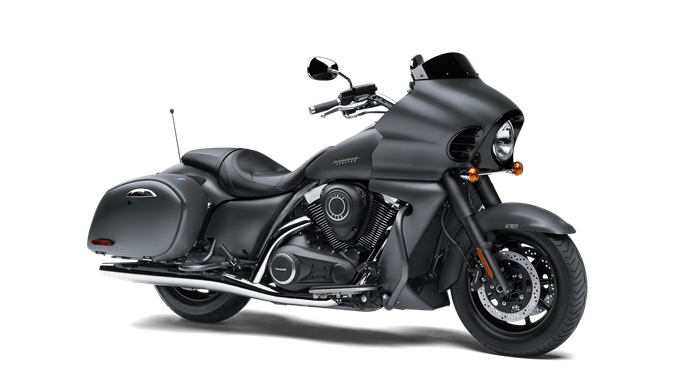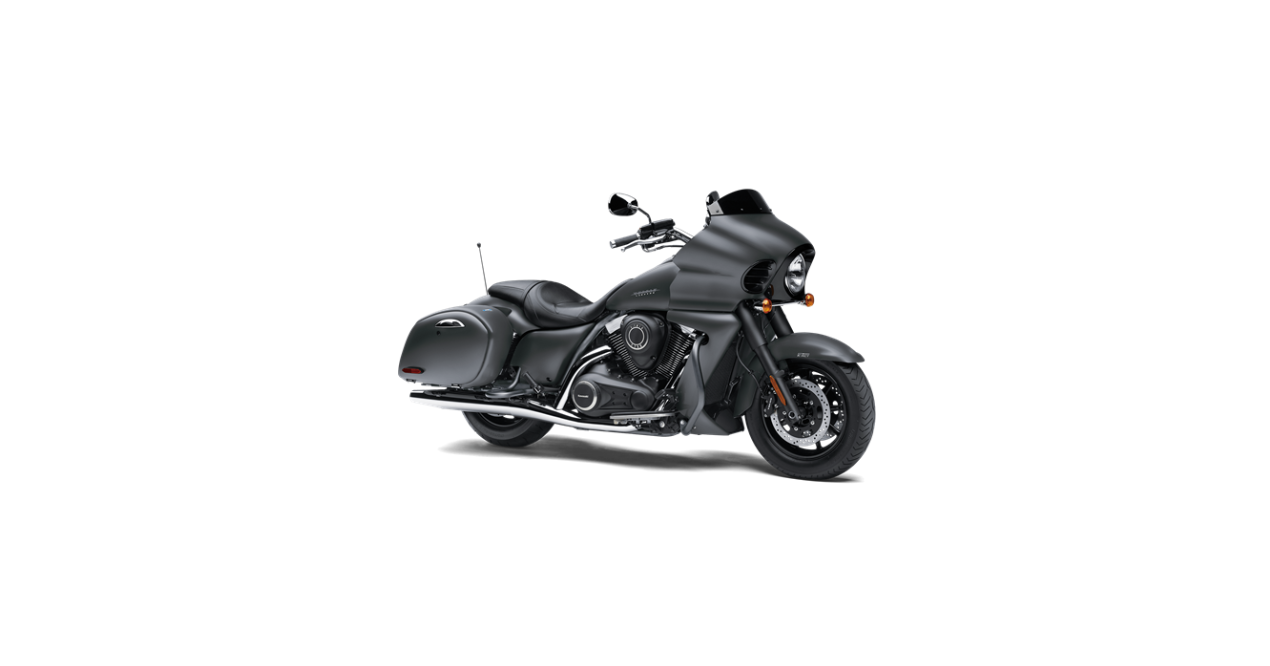2022 Kawasaki Vulcan 1700 Vaquero ABS Kawasaki Advanced Coactive-braking Technology (K-ACT) – Anti-lock Brake System (ABS)

Kawasaki Advanced Coactive-braking Technology (K-ACT) – Anti-lock Brake System (ABS)
K-ACT system supports the distribution of the front/rear brake force in an optimum balance to maintain a stable vehicle position. When using the front brake lever, the right and left front calipers and the rear brake operate. When using the rear brake pedal, the rear brake and the right front caliper operate. The cooperative brake balance is controlled optimally in response to the vehicle status such as the brake input and the vehicle speed. ABS is designed to help prevent the wheels from locking up when the brakes are applied hard while running straight. The ABS automatically regulates brake force. Intermittently gaining gripping force and braking force helps prevent wheel lock-up and allows stable steering control while stopping. Although the K-ACT system supports the distribution of the front/rear brake force in an optimum balance. The ABS provides stability while stopping by preventing wheel lock-up, remember the following characteristics:
- To apply the brake effectively, use the front brake lever and rear brake pedal simultaneously in the same manner as the conventional motorcycle brake system.
- K-ACT ABS cannot compensate for adverse road conditions, misjudgment or improper application of brakes. You must take the same care as with motorcycles not equipped with K-ACT ABS.
- ABS is not designed to shorten the braking distance. On loose, uneven or downhill surface, the stopping distance of a motorcycle with ABS may be longer than that of the equivalent motorcycle without ABS. Use special caution in such areas.
- ABS will help prevent wheel lock-up when braking in a straight line, but it cannot control wheel slip which may be caused by braking during cornering. When turning the corner, it is better to limit breaking to the light application of both brakes or not to brake at all. Reduce your speed be- fore you get into the corner.
- Same as a conventional brake system, excessive sudden braking may cause wheel lock up that makes it harder to control a motorcycle.
- During braking, K-ACT ABS will not prevent the rear wheel from lifting.
WARNING
K-ACT ABS cannot protect the rider from all possible hazards and is not a substitute for safe riding practices. Be aware of how the K-ACT ABS system operates and its limitations. It is the rider’s responsibility to ride at appropriate speeds and manner for weather, road surface and traffic conditions. - The computers integrated in the K-ACT ABS compare vehicle speed with wheel speed. Since non-recommended tires can affect wheel speed, they may confuse the computers, which can extend braking distance.
WARNING
The use of non-recommended tires may cause malfunctioning of K-ACT ABS and can lead to extended braking distance. The rider could have an accident as a result. Always use recommended standard tires for this motorcycle.
NOTE
- When the K-ACT system is functioning, you may feel a pulsing in the brake lever or pedal and feel a change of the braking touch. When the ABS is functioning, you may feel a pulsing in the brake lever or pedal. These are normal. Maintain braking pressure.
- K-ACT system does not function at the speed of approx. 20 km/h (12 mph) or below when the brake starts to be applied. ABS does not function at the speed of approx. 5 km/h (3. I mph) or below.
- K-ACT ABS does not function if the battery is discharged. When driving with an insufficiently charged battery, K-ACT ABS may not function. Keep the battery in good condition in reference to the “Battery maintenance ” section.
K-ACT ABS Indicator Light
Normally the K-ACT ABS indicator light goes on when the ignition switch is turned on and goes off shortly after the motorcycle starts moving. If the K-ACT ABS indicator light shows any of the following, a fault or faults may have taken place in the K-ACT ABS. You should have the K-ACT ABS checked by an authorized Kawasaki dealer.
- The light does not go on when the ignition switch is turned on.
- The light remains lit after the motorcycle starts moving.
- The light goes on.
Remember that the K-ACT ABS does not function when the indicator light is on. If the K-ACT ABS fails, the front and rear brakes work normally as a conventional brake system. However, the effectiveness of the brake, especially the rear brake, decreases compared to when the K-ACT system functions normally.
NOTE
- K-ACT ABS indicator light may go on under motorcycle riding conditions. (ex. The front or rear wheel races.) In this case, first turn the ignition key to “OFF”, and then back to “ON”. K-A CT ABS indicator light goes off by this operation, but if K-ACT ABS indicator light remains lit after the motorcycle runs at the speed of approx. 5 km/h (3. I mph) or below, you should have the K-ACT ABS checked by an authorized Kawasaki dealer.
- When the K-ACT ABS indicator light is blinking, the K-ACT ABS has been in the low voltage mode (the battery voltage decreases). When it is in the low voltage mode, the K-ACT system does not function, but the ABS functions. The ignition switch is turned off to recover the K-ACT system. At this time, the battery must be in normal condition. If the low voltage mode continues, you should have the K-ACT ABS checked by an authorized Kawasaki dealer.

